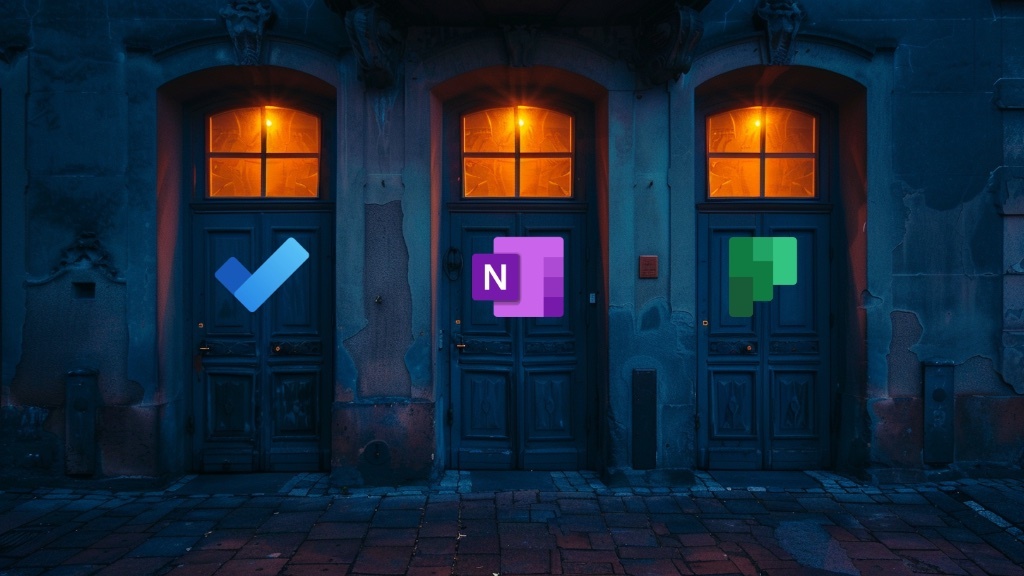Are you using OneNote, Planner, and To-Do for the right things?
Datum: 2024-10-02 09:10

Do you know what sets OneNote, Planner, and To-Do apart? All three are apps in the Microsoft 365 suite that many of my clients use. They all have great features but for three completely different purposes.
Too often, I see my clients writing things in To-Do that would be better suited for OneNote, and putting something in Planner that would have been perfect for To-Do. This makes their work unnecessarily complicated and exposes them to the risk of wasting time when they need it the most.
For you who prefer listening to reading, this post is also available as an episode of the “Done!” podcast:
So what are they for?
As I see it, each of the three tools is best for this:
- OneNote: meeting notes and other notes on things that are relevant to you now and that you may want to find at an indefinite time in the future, because you can make very free notes and still organize them in a structured way.
- To-Do: your to-do list, because To-Do can collect all your to-do tasks, and has good connections to Outlook, OneNote, Planner, Teams chat, and other tools in Microsoft 365.
- Planner: the plan for everything each person in the workgroup or the project has to do, because here you can get a clear overview of who is supposed to do what, when, and how far you have come on each major task.
That’s when things get messy
When you mix the uses of the three apps, you make things difficult for yourself. For example, I see clients:
- writing information that they need to remember but that should never be “completed” as a to-do task in To-Do. It could be something like “for customer category A, apply discount terms B.” The problem: Their to-do list then contains both tasks that need to be done and checked off, as well as things that don’t need to be done and shouldn’t be checked off, but on the surface, they look like the same thing. Instead, use OneNote (or another place) for this type of information.
- writing their to-do list on a page in OneNote. The problem: Even though they can put a checkbox before tasks in OneNote, the list quickly becomes unmanageable. They see everything at once, but at the same time, it isn’t easy to sort it by priority, deadline, time consumption, or similar. Use To-Do for your to-do list instead.
- keeping track of everything they have to do personally in Planner. The problem: Since the to-do list is preferably complete and contains everything you have to do, the board quickly becomes overwhelming if each task is added as a “card.” Or, it becomes difficult to get an overview of all tasks if the cards instead represent larger activities or projects, and the actual to-do tasks are in checklists on each card. Instead, try using To-Do for your to-do list.
Do this
- If you recognize that you mix the uses of Planner, OneNote, and To-Do, take some time to clarify what you use them for.
- If you find “good to know” information in To-Do, move it to OneNote.
- If you find to-do tasks in meeting notes in OneNote, move them to To-Do or set an Outlook flag to automatically end up in To-Do (while remaining in the meeting notes in OneNote).
- If you have to do tasks in checklists in cards in Planner, check to make sure they are also in To-Do or move them there, so you don’t have to do tasks in multiple places and miss out on the excellent overview.
Less division leads to less hesitation
If you clarify what you use OneNote, Planner, and To-Do for, you will have the right information in the right place. In your to-do list, everything will be able to be checked off, and you won’t have to navigate around and ignore other information that’s there when you’re choosing which task to tackle next.
When you need to write something down, you no longer have to hesitate about where to put it, but you can place it directly where it belongs and quickly move on.
How do you do it?
Of the mentioned apps, Planner is used the least by the people I help. Therefore, if you do, I’m curious to hear how you use it. Please email me and share your thoughts.
(By the way, do you know that you can let the to-do-list write itself in Microsoft 365?)
Want more like this?

If you want more tips on how to create good structure at work, there are many ways to get that from me - in podcasts, videos, books, talks and other formats.




